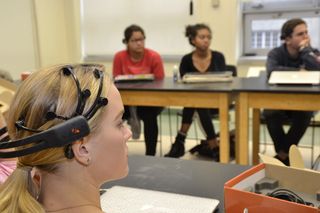Your Brain Waves May Show Whether You're Paying Attention in Class

You really can get on the same wavelength as someone else: In a new study, the brain waves of high school students synced up when they were highly engaged during a biology class.
On 11 days over the course of one semester, researchers hooked up all 12 of the students in a biology class to portable devices called electroencephalograms (EEGs) that measured their brain waves.
The more synced up a student's brain waves were with the brain waves of the rest of the students in the class, the more likely that person was to say that he or she enjoyed the class that day, according to the study, published today (April 27) in the journal Current Biology. For example, when the researchers analyzed brain waves called alpha waves, they found that students' waves were more likely to rise and fall at the same time as other students' waves when they were highly engaged in the class.
Likewise, when a student's brain waves were less synced with those of the rest of the class, the student was less likely to say that he or she was engaged. [10 Things You Didn't Know About the Brain]
"How well our brain waves sync up with those of another person appears to be a good predictor of how well we get along and how engaged we are," lead study author Suzanne Dikker, a psychology research scientist at New York University, said in a statement.
A student's engagement in a class and his or her social dynamics with the other students — including how well he or she got along with others — are critical for student learning, according to the study.
The researchers also looked at the link between brain waves and how students felt about the instruction they were getting.
Sign up for the Live Science daily newsletter now
Get the world’s most fascinating discoveries delivered straight to your inbox.
They found that when students' brain waves were more in sync, the students were more likely to say that they liked the instructor's teaching style, the study said.
The brain waves of pairs of students also synced up among students who said they were close friends. For example, when pairs of students who said they felt close to each other had face-to-face interactions before class, their brain waves were more in sync during class, the researchers found.
It's not entirely clear why students' brain waves sync up when they are engaged. However, the researchers said that the explanation may involve shared attention.
One limitation of the study was that it was carried out in a classroom, as opposed to in a controlled lab environment, the researchers said. On the other hand, the classroom setting allowed the researchers to study interactions and brain waves in a natural setting, they wrote. Indeed, the researchers made an effort to allow the students and the teacher to interact with one another as they would under normal circumstances, the researchers wrote.
In the future, the researchers hope to use the portable EEGs to study social interactions in other groups.
"The study offers a promising new method to investigate the neuroscience of group interactions," senior study author David Poeppel, a professor of psychology and neural science, also at New York University, said in a statement.
Originally published on Live Science.

Most Popular


